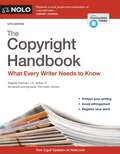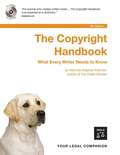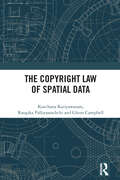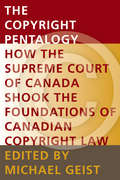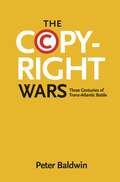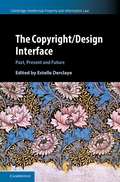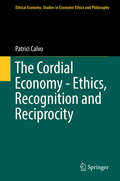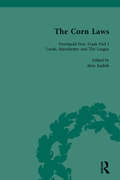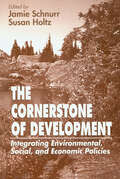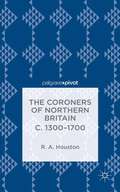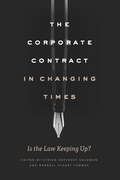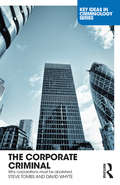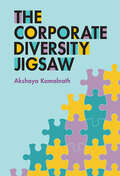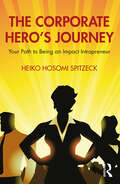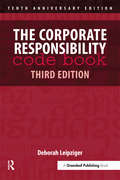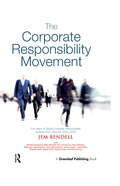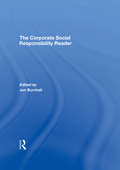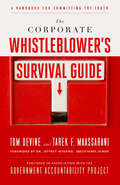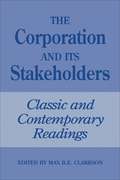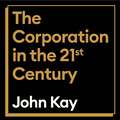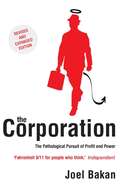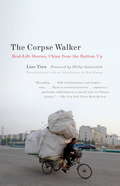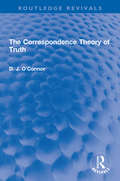- Table View
- List View
The Copyright Handbook
by Stephen Fishman J. D.This must-have handbook for writers and artists provides every necessary form to protect written expression under U. S. and international copyright law. With step-by-step instructions, it illustrates how to: register a written work with the copyright office determine what works can be protected transfer copyright ownership define and avoid infringement maintain electronic publishing rights This edition is completely updated to provide the latest case law and copyright regulations, including updates on all the latest cases and changes to copyright law and on electronic ling.
The Copyright Handbook: How to Protect and Use Written Works (9th edition)
by Stephen FishmanFishman is San Francisco-based intellectual property and business attorney who has written numerous self-help law books for Nolo Press. He offers copyright advice to writers of words (not music) in any genre, whether working freelance or for someone else, and for related professionals such as editors, publishers, librarians, and literary agents. First he summarizes the current copyright law in the US, then discusses particular problems or goals. The first edition appeared in 1992 and the most recent in 2002. Annotation ©2004 Book News, Inc., Portland, OR (booknews.com)
The Copyright Law of Spatial Data
by Kanchana Kariyawasam Rangika Palliyaarachchi Glenn CampbellThis book provides a thorough comparative analysis of copyright protection of spatial data across Australia, the United States of America (USA), and the European Union.With the emergence of terrestrial scanners, drones, robotics, and artificial intelligence (AI), the acquisition of data has recently reshaped the landscape of the survey industry, highlighting the importance of protecting the intellectual rights of surveyors. This book investigates the distinct approaches taken by each jurisdiction in protecting copyrights in spatial data and explores commonalities and disparities between these jurisdictions, highlighting best practices. The book also explores the alternative means of protecting spatial data and provides final recommendations aimed at policymakers, with the overarching objective of nurturing a balanced copyright system.This book will be of interest to students and scholars in the field of copyright law and spatial data.
The Copyright Pentalogy: How the Supreme Court of Canada Shook the Foundations of Canadian Copyright Law (Law, Technology and Society)
by Meera Nair Paul Daly Daniel Gervais Michael Geist Teresa Scassa Graham Reynolds Jeremy De Beer Carys Craig Giuseppina D’Agostino Greg Hagen Elizabeth F. Judge Ariel Katz Samuel Trosow Margaret Ann WilkinsonIn the summer of 2012, the Supreme Court of Canada issued rulings on five copyright cases in a single day. The cases represent a seismic shift in Canadian copyright law, with the Court providing an unequivocal affirmation that copyright exceptions such as fair dealing should be treated as users’ rights, while emphasizing the need for a technology neutral approach to copyright law. The Court’s decisions, which were quickly dubbed the “copyright pentalogy,” included no fees for song previews on services such as iTunes, no additional payment for music included in downloaded video games, and that copying materials for instructional purposes may qualify as fair dealing. The Canadian copyright community soon looked beyond the cases and their litigants and began to debate the larger implications of the decisions. Several issues quickly emerged. This book represents an effort by some of Canada’s leading copyright scholars to begin the process of examining the long-term implications of the copyright pentalogy. The diversity of contributors ensures an equally diverse view on these five cases, contributions are grouped into five parts. Part 1 features three chapters on the standard of review in the courts. Part 2 examines the fair dealing implications of the copyright pentalogy, with five chapters on the evolution of fair dealing and its likely interpretation in the years ahead. Part 3 contains two chapters on technological neutrality, which the Court established as a foundational principle of copyright law. The scope of copyright is assessed in Part 4 with two chapters that canvas the exclusive rights under the copyright and the establishment of new “right” associated with user-generated content. Part 5 features two chapters on copyright collective management and its future in the aftermath of the Court’s decisions. This volume represents the first comprehensive scholarly analysis of the five rulings. Edited by Professor Michael Geist, the Canada Research Chair in Internet and E-commerce Law at the University of Ottawa, the volume includes contributions from experts across Canada. This indispensable volume identifies the key aspects of the Court's decisions and considers the implications for the future of copyright law in Canada. - This book is published in English.
The Copyright Wars: Three Centuries of Trans-Atlantic Battle
by Peter BaldwinToday's copyright wars can seem unprecedented. Sparked by the digital revolution that has made copyright—and its violation—a part of everyday life, fights over intellectual property have pitted creators, Hollywood, and governments against consumers, pirates, Silicon Valley, and open-access advocates. But while the digital generation can be forgiven for thinking the dispute between, for example, the publishing industry and Google is completely new, the copyright wars in fact stretch back three centuries—and their history is essential to understanding today’s battles. The Copyright Wars—the first major trans-Atlantic history of copyright from its origins to today—tells this important story.Peter Baldwin explains why the copyright wars have always been driven by a fundamental tension. Should copyright assure authors and rights holders lasting claims, much like conventional property rights, as in Continental Europe? Or should copyright be primarily concerned with giving consumers cheap and easy access to a shared culture, as in Britain and America? The Copyright Wars describes how the Continental approach triumphed, dramatically increasing the claims of rights holders. The book also tells the widely forgotten story of how America went from being a leading copyright opponent and pirate in the eighteenth and nineteenth centuries to become the world’s intellectual property policeman in the late twentieth. As it became a net cultural exporter and its content industries saw their advantage in the Continental ideology of strong authors’ rights, the United States reversed position on copyright, weakening its commitment to the ideal of universal enlightenment—a history that reveals that today’s open-access advocates are heirs of a venerable American tradition.Compelling and wide-ranging, The Copyright Wars is indispensable for understanding a crucial economic, cultural, and political conflict that has reignited in our own time.
The Copyright/Design Interface: Past, Present and Future (Cambridge Intellectual Property and Information Law )
by Estelle DerclayeProtecting designs is complex and diverse; it involves deciding whether to protect them by design law, copyright law, or by both laws. A single protection may be under- or overprotective but two or more can be overprotective if there are no rules regulating the overlap. Legal systems in Europe and abroad have struggled to find the most adequate solution to this problem. This book traces the history of the design/copyright interface of 15 countries, selected for their diversity in the way they dealt with the interface. It examines how these countries have coped with the problems engendered by the interface, the rules they applied to it over time and the reasons for legislative changes. This analysis reveals the most appropriate rules to regulate the interface at EU and global level and will appeal to academics, practising lawyers, judges, students and policymakers all over the world.
The Cordial Economy - Ethics, Recognition and Reciprocity (Ethical Economy #55)
by Patrici CalvoThis book proposes, from a civil perspective —such as that developed by Stefano Zamagni— and a cordial perspective —such as that developed by Adela Cortina—, orientations to design an economy in tune with what the historical moment demands. Among other things, this comes from encouraging institutions, organisations and companies to include in their designs aspects as important for carrying out their activities as cordial reciprocity, mutual recognition of the communicative and affective capacities of the linked or linkable parties, public commitment and the active participation of civil society.The book first shows the conceptualisation of the process of self-interest as operating for one’s own benefit and its inclusion in the orthodox economic model. In Chapter 2 it then displays some of the logical/formal and experimental limits of the axiomatic economics model to discover the possibility of building bridges between theoretical modelling and factual validation. Chapter 3 demonstrates the fragility of a rationality model based on the paradigmatic figure of homo oeconomicus. Chapter 4 reflects on the critical process that has identified reciprocity as a determining factor for human cooperation, turning this behaviour into a paradox in which the lack of a reasonable explanation from the selfish perspective becomes inconsistent in the predominant economic theory. Chapter 5 is from a moral point of view it describes and criticises the different approaches to reciprocity observed by sociologists, biologists, psychologists and economists. Chapter 6 analyses three mutual recognition proposals as possible foundations for human cooperation, highlighting one of them –cordial recognition, developed by Cortina– because it is more closely related to studies of reciprocity, particularly the most recent contributions from the neurosciences. Chapter 7 proposes cordial reciprocity as a horizon of meaning for the various approaches to reciprocity observed. Chapter 8 explores the possible emergence and development of cordial goods, a type of relational and communicative good that enables joint actions to take place in different contexts of human activity. Chapter 9 analyses the application and implementation of cordial reciprocity at the macro, meso and micro levels of the economy. And finally, it proposes guidelines for designing a monitoring and compliance system which, based on the communication, storage and processing of big data and the committed participation of stakeholders, offers businesses the possibility of inspecting their underlying dimensions of morality, emotions and responsibility.
The Corn Laws Vol 5: The Formation Of Popular Economics In Britain
by Alon KadishThe pamphlets, newspaper articles and tracts in this collection provide source material for the study of the Anti-Corn Law campaigns of the 1830s and 1840s and their role in the formation of popular economics in Britain. Volume 5 covers entries from 1839 to 1842.
The Cornerstone of Development: Integrating Environmental, Social, and Economic Policies
by Jamie Schnurr 0 Idrc Susan Holtz Greg Armstrong Anne K Bernard"Sustainable development" quickly became the universal goal for environmentalists in the 1990s, motivated by the 1988 Brundtland Report and the 1992 Earth Summit in Rio. When the time came to bring theory into reality, sustainable development revealed far more complexity than first anticipated.To attain sustainable development in the full sense of the phrase"meeting present needs without compromising the resources needed for future societies"environmental and social concerns would need a constant presence in all major economic decisions.The Cornerstone of Development: Balancing Environmental, Social, and Economic Imperatives profiles many of the first attempts to implement sustainable development initiatives worldwide. The model: Canada's experience with "multistakeholder" decision-making. Under the guidance of Canada's National Task Force on Environment and Economy, nationwide and provincial round tables brought government officials together with corporate officers to formulate sustainable development guidelines.Authorized by the Canadian government to serve as an "Agenda 21 organization," the International Development Research Centre (IDRC) subsequently researched the feasibility of adapting the multistakeholder approach to the needs and practices of developing countries. The results are in these pages: valuable case histories from Africa, Latin America, Asia and Canada, each recounting the risks and benefits from integrating environmental, social and economic policies.When IDRC members were asked for ways to address environmental sustainability, they had few examples to follow"and little evidence that such endeavors could be fulfilled. The research and problem-solving efforts they produced are now collected here, for the guidance of other environment/development balance programs worldwide.
The Coroners of Northern Britain c. 1300–1700
by R. A. HoustonFor the last 800 years coroners have been important in England's legal and political landscape, best known as investigators of sudden, suspicious, or unexplained death. Against the background of the coroner's role in historic England, this book explains how sudden death was investigated by magistrates in Scotland.
The Corporate Contract in Changing Times: Is the Law Keeping Up?
by Steven Davidoff Solomon Randall Stuart ThomasOver the past few decades, significant changes have occurred across capital markets. Shareholder activists have become more prominent, institutional investors have begun to wield more power, and intermediaries like investment advisory firms have greatly increased their influence. These changes to the economic environment in which corporations operate have outpaced changes in basic corporate law and left corporations uncertain of how to respond to the new dynamics and adhere to their fiduciary duties to stockholders. With The Corporate Contract in Changing Times, Steven Davidoff Solomon and Randall Stuart Thomas bring together leading corporate law scholars, judges, and lawyers from top corporate law firms to explore what needs to change and what has prevented reform thus far. Among the topics addressed are how the law could be adapted to the reality that activist hedge funds pose a more serious threat to corporations than the hostile takeovers and how statutory laws, such as the rules governing appraisal rights, could be reviewed in the wake of appraisal arbitrage. Together, the contributors surface promising paths forward for future corporate law and public policy.
The Corporate Criminal: Why Corporations Must Be Abolished (Key Ideas in Criminology)
by David Whyte Steve TombsDrawing upon a wide range of sources of empirical evidence, historical analysis and theoretical argument, this book shows beyond any doubt that the private, profit-making, corporation is a habitual and routine offender.? The book dissects the myth that the corporation can be a rational, responsible, 'citizen'.? It shows how in its present form, the corporation is permitted, licensed and encouraged to systematically kill, maim and steal for profit.?? Corporations are constructed through law and politics in ways that impel them to cause harm to people and the environment.? In other words, criminality is part of the DNA of the modern corporation.? Therefore, the authors argue, the corporation cannot be easily reformed.? The only feasible solution to this 'crime' problem is to abolish the legal and political privileges that enable the corporation to act with impunity.
The Corporate Diversity Jigsaw
by Akshaya KamalnathAlthough diversity in companies is a topic of great interest, significant aspects of the issue are often left out of the debate. The Corporate Diversity Jigsaw connects all the dots so that steps taken to address issues of diversity in business organisations can be more effective. Akshaya Kamalnath offers a nuanced justification of exactly what types of diversity are most useful for corporations, where they should be implemented, and how best to address diversity in ways that account for recent social movements such as #MeToo and Black Lives Matter. After a critical assessment of quotas and disclosure requirements across jurisdictions, she provides a different way to solve the problem, by encouraging companies to make improvements to their culture and internal processes. This timely book offers a balanced analysis, practical solutions, and fresh perspectives on how corporate culture and social movements impact diversity efforts.
The Corporate Hero's Journey: Your Path to Being an Impact Intrapreneur
by Heiko Hosomi SpitzeckImpact intrapreneurs at some of the most powerful organizations in the world are designing new, more sustainable businesses from within. They put their values to work and transform their corporations into a force for good. In a corporate world that still largely prioritizes profit above all else, these people shine a light on how to balance profit with impact, and the inspirational stories captured in this book guide leaders and managers to do the same.The lack of purpose beyond profit is causing millions of people to question their work and even to leave the corporate world altogether. Companies are struggling with recruitment and retention, as people seek a greater sense of purpose. For many, this would mean finding a way to use their work as a platform for positive social and environmental impact. This book will inspire this change for leaders seeking a different and better way forward. Structured around the stages of Joseph Campbell’s hero’s journey – upon which Star Wars was based – this book combines the philosophy of Star Wars with inspiring stories of impact intrapreneurs. You’ll get to know Corporate Jedi such as Susie Lonie and Nick Hughes, who, while working for Vodafone in Kenya introduced a mobile payment method which brought financial inclusion to millions; Myriam Sidibé at Unilever, who turns making soap into saving lives; and Gib Bulloch, founder of Accenture Development Partnerships, which provides first-class consulting services to NGOs leveraging their impact. With actionable advice, such as how to create a business case, how to measure social impact, and more, the book is not only an entertaining read, but also helps executives apply insights to their own daily work.Written for leaders, managers, and all professionals looking to create positive impact through their work, this book will give future Corporate Jedi the courage and tools to use the force of business for good.
The Corporate Responsibility Code Book
by Deborah LeipzigerThe Corporate Responsibility Code Book has become the go-to guide for companies trying to understand the landscape of corporate responsibility and searching for their own, unique route towards satisfying diverse stakeholders. There is no one-size-fits-all approach. A company may face quite different challenges if it operates in more than one part of the world. And yet stakeholders, especially consumers and investors, are keen for some degree of comparability with which they can evaluate corporate performance. There are countervailing forces at work within corporate responsibility: on the one hand is the need for convergence in order to simplify the large numbers of codes and standards; and, on the other hand, the need to foster diversity and innovation.Many of the best codes of conduct and standards are not well known, while some CR instruments that are well disseminated are not terribly effective. Some comprehensive codes of conduct achieve nothing, while other quite vague codes of conduct become well embedded into the organization and foster innovation and change. This landmark book explains the best CR instruments available, and distils their most valuable elements.In the fully revised third edition, Deborah Leipziger widens her lens to provide detailedanalysis of the UN Guiding Principles on Business and Human Rights, the Gender EqualityPrinciples and ISO 26000 while updating other key tools such as the Equator Principles, the OECD guidelines and GRI’s new G4 framework.The codes in this book cover a wide range of issues, including human rights, labour rights,environmental management, corruption and corporate governance. The book also includeshow-to (or process) codes focusing on reporting, stakeholder engagement and assurance.
The Corporate Responsibility Movement: Five Years of Global Corporate Responsibility Analysis from Lifeworth, 2001-2005
by Jem BendellCorporate social responsibility is now an established agenda for large companies, with a new profession emerging that engages in the social and environmental contribution of business. How has this agenda emerged over time? What were the key events and actors? How has this new "movement" of committed individuals been taking shape around the globe? Insights into these questions come from a review of the first half of first decade of the 21st century. The Corporate Responsibility Movement compiles Lifeworth's highly praised Annual Reviews of Corporate Responsibility from 2001 to 2005.It is introduced with a new overview by the lead author of those reviews, Dr Jem Bendell, in a piece that examines the trajectory of a new social movement in and around business. At a time of searching questions about the future of finance, Dr Bendell argues that a new concept of "capital democracy" is emerging from within the community of people working towards corporate responsibility, which could be mainstreamed as a socially and environmentally enhanced system of economy. He calls on professionals, researchers and policy-makers to embrace an ambitious agenda for corporate responsibility and develop greater insight into acting together as a movement for change.This book is an essential resource for business libraries, recording, analysing and contextualising some of the key events, issues and trends during this historic period in the development of the corporation.
The Corporate Social Responsibility Reader
by Jon BurchellIn the age of global capitalism, shareholders, and profits are not the only concerns of modern business corporations. Debates surrounding economic and environmental sustainability, and increasing intense media scrutiny, mean that businesses have to show ethical responsibility to stakeholders beyond the boardroom. A commitment to corporate social responsibility may help the wider community. It could also protect an organization’s brand and reputation.Including key articles and original perspectives from academics, NGOs and companies themselves, The Corporate Social Responsibility Reader is a welcome and insightful introduction to the important issues and themes of this growing field of study. This book addresses:the changing relationships between business, state and civil societythe challenges to business practicewhat businesses should be responsible for, and whyissues of engagement, transparency and honestythe boundaries of CSR – can businesses ever be responsible?While case studies examine major international corporations like Coca Cola and Starbucks, broader articles discuss thematic trends and issues within the field. This comprehensive but eclectic collection provides a wonderful overview of CSR and its place within the contemporary social and economic landscape. It is essential reading for anyone studying business and management, and its ethical dimensions.
The Corporate Whistleblower's Survival Guide: A Handbook for Committing the Truth
by Tarek F. Maassarani Tom DevineFrom Erin Brockovich to Enron, whistleblowers who “challenge abuses of power that betray the public trust” have proven to be an unfortunate necessity in modern business culture. Their efforts to report crimes, fraud, and dangers to public health and safety have saved millions of lives and billions of dollars of shareholder value – and had we heeded the warnings of whistleblowers, perhaps disasters such as the Bernie Madoff scandal and the Lehman Brothers meltdown could have been averted. Recent federal legislation in finance and health reform have cemented legal protections and mechanisms for whistleblowing. This book provides a thorough guide and history to the whistleblower's legal rights. The ultimate survival guide, it provides advice on getting help and finding allies, warns that retaliation is often the reward for "committing the truth" and shows how to weather the storm. With extensive legal texts, sample letters, resources, and information on upcoming whistleblower reforms, this is the ultimate source on the subject.
The Corporation and Its Stakeholders: Classic and Contemporary Readings (The Royal Society of Canada Special Publications)
by Max ClarksonThere is an active debate over whether the traditional purpose of the corporation – to maximize profits and financial value for the benefit of shareholders – can adequately encompass the interests of all other participants or stakeholders in the corporation's activities. Since a corporation cannot operate optimally without the support of its most important stakeholders, particularly its employees and customers, finding ways of incorporating responsiveness to stakeholder needs is vital for corporate management and governance. This anthology is designed to sharpen the debate about the role and purpose of the corporation. The debate includes such fundamental questions as: Who should be considered stakeholders? Which stakeholder interests should a corporation take into account? How should stakeholder interests be balanced against shareholder objectives (such as profits)? What changes should be made in corporate decision making and governance to reflect these new interests? This collection of seminal articles, is divided into three parts: Shareholders and Stakeholders; Morality, Ethics and Stakeholder Theory; and Stakeholder Theory and Management Performance. The articles date from 1916 to 1997, and are drawn from North American and European authors. Managers as well as researchers will find this collection presented will stimulate their thinking on the role of the corporation and its responsiveness to stakeholder interests. The volume is funded in part by a grant from the Alfred P. Sloan Foundation.
The Corporation in the Twenty-First Century: Why (almost) everything we are told about business is wrong
by John KayFor generations, we have defined a corporation as a business run by a capitalist elite, that uses its accumulated wealth to own the means of production and exercise economic power. That is no longer the reality. In the twenty-first century, our most desired goods and services aren't stacked in warehouses or on container ships: they appear on your screen, fit in your pocket or occupy your head. But even as we consume more than ever before, big business faces a crisis of legitimacy. The pharmaceutical industry creates life-saving vaccines but has lost the trust of the public. The widening pay gap between executives and employees is destabilising our societies. Facebook and Google have more customers than any companies in history but are widely reviled. John Kay, one of the greatest economists of our time, describes how the pursuit of shareholder value has destroyed some of the leading companies of the twentieth century. Incisive and provocative, this book redefines successful commercial activity and leadership, the knowledge economy and what the future of the modern corporation might be.'A brilliant analysis of how business really works. Informative, funny, and full of deep insights' - Mervyn King 'A very entertaining read' - Evan Davis
The Corporation: The Pathological Pursuit of Profit and Power
by Joel BakanNew Edition What would the world be like if its ruling elite was insane? The most powerful class of institution on earth, the corporation, is by any reasonable measure hopelessly and unavoidably demented. The corporation lies, steals and kills without remorse and without hesitation when it serves the interests of its shareholders to do so. It obeys the law only when the costs of crime exceed the profits. Corporate social responsibility is impossible except insofar as it is insincere. At once a diagnosis and a course of treatment, The Corporation is essential reading for those who want to understand the nature of the modern business system. It is a sober and careful attempt to describe the world as it is, rather than as corporate public relations departments would have us believe it to be. It reveals a world more exotic and more terrifying than any of us could have imagined. And although a billion dollar industry is trying to convince you otherwise, the corporations that surround us are not our friends. Charming and plausible though they are, they can only ever see us as resources to be used. This is the real world, not science fiction, and it really is us or them.
The Corporatization of American Health Care: The Rise of Corporate Hegemony and the Loss of Professional Autonomy
by J. Warren Salmon Stephen L. ThompsonIn this book, the authors, as policy analysts, examine the overall context and dynamics of modern medicine, focusing on the changing conditions of medical practice through the lens of corporatization of medicine, physician unionization, physician strikes, and current health policy directions. Conditions affecting the American medical profession have been dramatically altered by the continuing crises of cost increases, quality concerns, and lack of access facing our population, along with the ongoing corporatization toward bottom-line dictates. Pressures on practitioners have been intensifying with much greater scrutiny over their clinical decision-making. Topics explored among the chapters include:History of the Corporatization of American Medicine: The Market Paradigm ReignsPharmaceuticals, Hospitals, Nursing Homes, Drug Store Chains, and Pharmacy Benefit Manager/Insurer IntegrationMedical Practice: From Cottage Industry to Corporate PracticeMedical Malpractice Crisis: Oversight of the Practice of MedicineBig Data: Information Technology as Control over the Profession of MedicinePhysician Employment Status: Collective Bargaining and StrikesThe Corporatization of American Health Care offers different perspectives with the hopes that physicians will unite in a new awareness and common cause to curtail excessive profit-making, renew professional altruism, restore the charitable impulse to health provider institutions, and unite with other professionals to truly raise levels of population health and the quality of health care. It is also a necessary resource for health policy analysts, healthcare administrators, health law attorneys, and other associated health professions.
The Corpse Walker
by Liao YiwuThe Corpse Walker introduces us to regular men and women at the bottom of Chinese society, most of whom have been battered by life but have managed to retain their dignity: a professional mourner, a human trafficker, a public toilet manager, a leper, a grave robber, and a Falung Gong practitioner, among others. By asking challenging questions with respect and empathy, Liao Yiwu managed to get his subjects to talk openly and sometimes hilariously about their lives, desires, and vulnerabilities, creating a book that is an instance par excellence of what was once upon a time called "The New Journalism." The Corpse Walker reveals a fascinating aspect of modern China, describing the lives of normal Chinese citizens in ways that constantly provoke and surprise.From the Trade Paperback edition.ws (conducted between 1990 and 2003) with sensitivity and patience, working both from notes and from his own memory of these remarkable conversations. The result is an idiosyncratic, powerful, and richly revealing portrait of a people, a time, and a place we might otherwise have never known.From the Hardcover edition.
The Correctional Officer: A Practical Guide
by Gary CorneliusThe job of today's correctional officer is a demanding one, whether it is working in an adult prison or in a local jail. The correctional officer has the responsibility to safely confine criminal offenders, and, by doing so, properly keeps the public safe. This book is meant to give the reader, whether a student or a trainee, a clear, realistic understanding of what correctional officers do―from patrolling cellblocks, preventing escapes and handling security issues to dealing with various types of offenders and their behaviors. Written by a retired jail officer and adjunct professor with over 27 years of experience in confinement, classification, community corrections, correctional officer training and corrections policy development.
The Correspondence Theory of Truth (Routledge Revivals)
by D. J. O'ConnorFirst published in 1975, The Correspondence Theory of Truth examines the simplest statements of empirical fact and establishes what we can mean when we say that such statements are true. In particular, the author has considered whether any or all of beliefs, sentences, statements, or propositions are properly said to be true or false. He proceeds to examine what we mean by the term ‘fact’ and what possible relation between facts and beliefs (or their linguistic embodiments) could be meant by the term ‘correspondence’. The second part of the book is a critical survey of important contemporary accounts of truth. The author examines Tarski’s semantic theory to see if it offers a satisfactory reconstruction of the essence of the traditional notion of correspondence, then J.L. Austin’s recent and famous version of the correspondence theory and some criticisms of it by Professor P. E. Strawson. A final chapter summarizes the viable content of the correspondence theory and suggests what problems about truth still remain for discussion if the theory is accepted. This book will be an essential read for students and scholars of Philosophy.
